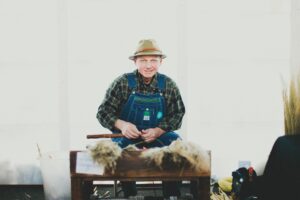I’ve always been in awe of makers. It started with the admiration I had for my grandaddy John, an engineer who devoted his retirement years to his backyard shop in rural Mississippi where he refined his carpentry skills. His son, my dad, is just as good with his hands and claims more than my admiration; he’s got my adoration. A surgeon by day (and many, many nights), until his own recent retirement, he didn’t have consistent pockets of time for hobbies like fishing or golf but also, couldn’t easily “sit and relax,” so he was always fooling with cars, fiddling with house projects and, like his dad, making things.
I’d spend hours hanging out in our garage and watch him under a hood (or under a car) twisting and torquing. When he was repairing or building something with wood, I’d swoon over the smells of varnish and sawdust. (If someone would make a perfume blending these two aromas — light on the varnish — I’d buy it.)
Around age nine, when I was invited to join him in making a mahogany side table, I was ready to measure twice, cut once. Sand with the grain, never forgetting corners. Go over every inch with a tack cloth to pull off every speck of dust and use long, even strokes to brush on stain. I have that table in my house now and never look at it without wading through a flood of fond memories.

(Michelle Consuegra/Contributed)
Today, I’m still fascinated by makers. And my use of the term is highly inclusive. I’m talking about folks who sew, paint, sculpt, carve, build, bake and grow. Those whose craft and art and toil and time result in something that didn’t exist before. Something new. Something created. Something made. I want to know how they make, but more than that, I want to know why. Where do the ideas come from? What drives them to expend the effort, to take the risks, to keep going when it’s hard? Luckily for me, it’s often part of my job to meet makers, watch them at work, engage in conversations and ask these questions.
Recently, I did this multiple times over several months. I used all that I learned to tell the makers’ meaningful stories. These tales were paired with photos of said makers and then compiled together in a book entitled “Southern Makers.” And in a few weeks, the book will be out in the world, ready to share it all with you.
Find out what makes found-object artist the Tin Man tick. See a walk in the woods through broom-maker George Jones’ eyes. Get a little taste of the secret ingredient stirred into JaWanda’s Sweet Potato Pies. Learn more about chef Rob McDaniel’s approach to food. It’s all contained in “Southern Makers’” pages.
Every individual maker profiled in the book is contributing something special with their hands, heads and hearts, but collectively, they do even more. They paint a dynamic picture of the creativity and innovation that connect in a web — mirroring Alabama’s countless waterways —and flow across the entire state.

(Michelle Consuegra/Contributed)
No way did I make this book alone. It was a collaboration, with the makers themselves playing the pivotal role. And other hands were at work too, including multiple talented photographers. You can flip through and understand why makers matter without ever reading a word, such is the strength of their images.
Every detail of the book’s design was thoughtfully (sometimes painstakingly) shepherded and executed by art director, Erika Tracy. She selected font style, size and color; directed photo shoots and chose which images to use where and how big or small to run them; picked the paper weight and finish; chose the margin width that gives pages luxurious white space in just the right places; and managed many additional aspects, from over-arching aesthetic to nit-picky nuances. If an initial glance grabs you and draws you in, that’s her work. If casually thumbing through it or diving all the way in is a pleasant experience, again, she’s the one to thank.
Finally, Garlan and Heather Gudger, who are founders of Southern Makers and are the sole driving force behind it today, curated and oversaw every step of the book, including the creation of the handsome cover (which took time to achieve but was more than worth the wait). It’s true that the makers in the book are its soul, but as their stalwart champions, the Gudgers are just as significant. And, they’re makers too, and not just makers of this book. The couple owns Southern Accents Architectural Antiques in Cullman. The business, started by Garlan’s father in 1969, and carried on and expanded by the Gudgers, rescues, preserves and sometimes, reimagines, historic architectural treasures (from doorknobs to massive mantle surrounds and everything in between), saving these elements’ stories and giving them new life and use in the modern age. I can’t thank them enough for allowing me to be a part of this project.
And about that wait. Making a book is a laborious process, and sometimes, there are delays. While the books aren’t ready just yet, they will be at the end of January. You can find more details and pre-order a copy (or two!) now at southernmakersrevival.com.




